C... what it takes to change. What does it take for social innovation and renewal to flourish? With symposia, exhibitions, performances and concerts, the Ars Electronica Festival 2014 in Linz, Austria, from September 4 to 8, 2014, turned its attention to the theme of change.
Since its inception in 1979, the Ars Electronica Festival has been scrutinizing reciprocities operational at the nexus of art, technology and society. In 2014, Ars Electronica took leave of its traditional venues and boldly ventured forth as never before into the public sphere of downtown Linz. C… what it takes to change.
DAY 1
Opening Parcours
[one_half]The five-day festival in Linz kicked off with an Opening Parcours featuring an itinerary that included all festival locations. This stroll offered visitors a splendid opportunity to get an overview and do some meet & greet with the artists and curators. The tour’s point of departure was the just-opened “Device Art” exhibition that’s running in the Ars Electronica Center until the end of June 2015. (Photo credit: Tom Mesic)[/one_half][one_half_last]
“Device Art was an outgrowth of fabrication traditions handed down from generation to generation and of a uniquely Japanese aesthetic. In traditional Japanese culture, there are works of art in which technology and art blend beyond the point of discernible differentiation.” Prof. Hiroo Iwata
[/one_half_last]
Story Weaver
In Deep Space, the ancient tale of the “Story Weaver” was augmented with music performed by pianist Maki Namekawa and illustrations by artist Emiko Ogawa. The Opening Parcours then continued on its way into the inner city. (Photo credit: Tom Mesic)
Future Innovators Summit
[one_half]In the meantime, the first get-together of the Future Innovators was already underway in the classrooms of the Akademisches Gymnasium. In spaces in which, normally, students spend school hours trying to find answers to questions, young innovators in the fields of art and design, engineering, start-ups and social activism spent several days in small groups discussing who and what it takes for creativity and innovation to proliferate.(Photocredit: Florian Voggeneder)
[/one_half][one_half_last]
“What’s even more surprising is that there’s not a single event at which these inspiring talents, doers and innovators can convene to talk and work with one another beyond the narrow confines of their own individual disciplines. But this is exactly the kind of crossover we’re seeking!”, Hideaki Ogawa
[/one_half_last]
CyberArts 2014
[one_half]
“Everyone should have the possibility to take advantage of exactly the same tax reduction strategies that major corporations are exploiting.”, Paolo Cirio
[/one_half][one_half_last]Once again this year, outstanding works by the current winners of thePrix Ars Electronica, the media art prize bestowed annually, were exhibited in the OK Center for Contemporary Art. There were 2,703 projects from 77 countries submitted for 2014 Prix Ars Electronica prize consideration in Computer Animation, Interactive Art, Digital Communities, [the next idea] voestalpine Art and Technology Grant competition, u19 – CREATE YOUR WORLD and the new Visionary Pioneer of Media Art category. CyberArts 2014 showcased a selection of the entries. (Photocredit: Florian Voggeneder)[/one_half_last]
The balancing sofa by Jacob Tonski was one of the many highlights of the CyberArts exhibition. (Photo credit: Florian Voggeneder)
“Balancing is very complex and difficult, and nevertheless we do it, seemingly effortlessly, all the time.”, Jacob Tonski
Studying Art
The Opening Parcours on Day 1 continued on through two additional exhibitions at venues adjacent to Linz’s Main Square. This year’s Campus Exhibition presented works by students and faculty members in Linz Art University’s Interface Cultures program as well as by their Belgian counterparts at arts2 – École supériere des arts. (Photocredit: Florian Voggeneder)
[one_half]
“The propagation of social and mobile media has dramatically changed how we deal with media in everyday life, so that interaction is now something we take completely for granted.”, Christa Sommerer
[/one_half]
[one_half_last]
“It’s not something optional that can be added at the end of a process. With every step you take, you have to keep the programming in mind.”, François Zajéga
[/one_half_last]
Buddha on the Beach
Festivalgoers could behold the global crises from the perspective of Taiwanese artists in the “Buddha on the Beach” exhibition that extended through multiple venues around FestivalCity in downtown Linz. (Photo credit: Florian Voggeneder)
“In times of crisis, people increasingly seek stability with God or with Buddha. But if Buddha were on the beach, would he then try to save the world in order to help us, or would he be there to take a vacation because he’s too tired and would like to take a little break.”, I-Wei Li
Visionary Pioneers of Media Art
Roy Ascott (on the right in this picture) is a British artist, theoretician and visionary thinker whose oeuvre has exerted a formative influence on many international media artists. Ascott is the first honoree in the “Visionary Pioneers of Media Art” category launched this year by the Prix Ars Electronica, and was one of the most prominent festival guests this year. (Photo credit: Florian Voggeneder)
“It isn’t easy to precisely describe this now, but I think it means having a pretty clear idea of what it is that we wish for the future. And this is a matter of having access to hands, tools, people and situations, and being able to bring them together in order to accomplish something.”, Roy Ascott
Personal Encounters
The intensive conversations held at the Future Innovators Summit eextended from Thursday to Sunday, from breakfast to dinner. Discussions, workshops and speeches made up the jam-packed program for young innovators. And what did they have to say about the proceedings? (Photocredit: Tom Mesic)
[one_third]
“It was awesome! I liked the concept of having it in separate locations – this made me think outside of the box. I wasn’t confined in my creativity. It allowed me room free and room wide to be very creative.”, Oscar Ekponimo
[/one_third]
[one_third]
“I have never been to a gathering were it has been as efficient as here. On top of all the other stuff – I’m really inspired. I have met people that I will gonna be in touch with for the future, professional relationships, peers. A very positive experience.”, Harald Haraldsson
[/one_third]
[one_third_last]
“I liked a lot. Discussion sessions and moments where I had a kind of spark of inspiration, maybe from one of the mentors and afterwards reflecting on that, how it is related. Those sessions were really nice.”, Tuuli Utriainen
[/one_third_last]
Illuminating Ideas at Night
After sundown, the spacious plaza in front of Linz’s St. Mary’s Cathedral morphed into a stage for brilliantly lit, interactive media art projects. One of the highlights on the “Domplatz Nightline” lineup was “Water Light Graffiti,” an illuminated wall studded with water-sensitive LEDs. (Photocredit: Florian Voggeneder)
“My wish for the future is to design a building material that’s capable of interacting with the weather.”, Antonin Fourneau
A Cathedral as Media Façade
At “Archifon III” and”OscFluctuation” on the first evening of Ars Electronica, hundreds of festivalgoers assembled in front of St. Mary’s Cathedral to experience these two visualizations live and to codetermine their configuration. Participants could use a laser pointer to generate effects on the church’s façade and to project silhouettes on the front of a nearby hotel. (Photocredit: Tom Mesic)
Cathedral Exhibit
Plenty of square footage for a series of artistic installations was made available in the interior of Austria’s largest church. The nave, crypt and Rudigier Hall enveloped festivalgoers in a unique atmosphere bot. (Photo credit: Tom Mesic)
Mentors
Hiroshi Ishii, Golan Levin, Robert Madelin, K. Bradley Paxton, Joachim Sauter and Oliviero Toscani – talks by the mentors at the Future Innovators Summit iinspired young creatives and festival audiences alike. (Photocredit: Florian Voggeneder)
Festival Facts & Figures
[bullets style="blue"]
- 85,000 visits
- 579 artists and scientists from 59 countries
- 427 individual events
- 114 guided tours
[/bullets](Photocredit: Florian Voggeneder)
DAY 2
Far removed from reality and yet …
“Mirage” by the Grinder Man artists’ collective transported visitors in Linz’s Cathedral to worlds far removed from reality, whereby the transition between the present and the past seemed to have no beginning and no end. (Photocredit: Tom Mesic)
… realistic at the same time
On Day 2 of the festival, one of the many inspiring speeches delivered in conjunction with the Future Innovator Summit was by Sanjit Bunker Roy, the founder of Barefoot College that teaches women in rural India to use solar energy for electrical current and light, and to construct their own lamps, cookers, parabolic mirrors and solar elements. (Photocredit: Florian Voggeneder)
Ars Electronica Right in the Heart of Town
A bank lobby was just one of the many locations in Linz that hosted Ars Electronica productions this year. The list of sites included shops, courtyards, gardens, underground garages, streets and squares, gymnasiums and classrooms, as well as a cathedral along with its parish house and bishop’s residence. (Photo credit Florian Voggeneder)
Gala
The world’s foremost practitioners of media art were the stars of the show on Friday evening. At the big 2014 Ars Electronica Gala, the Golden Nica statuettes were bestowed upon the Prix Ars Electronica prizewinners. The spotlight was on the artists themselves; their audience was made up of approximately 1,200 guests and media outlet representatives from all over the world. (Photocredit: Florian Voggeneder)
he 2014 Prix Ars Electronica prizewinners (Photo credits: Florian Voggeneder)
Gerfried Stocker, artistic director of Ars Electronica (left in this picture), hands a Golden Nica to a young lady named Sarah Oos, the winner in u19 – CREATE YOUR WORLD. (Photocredit: Florian Voggeneder)
DAY 3
The Next Breakfast Is Sure to Be Served
Day 3 at the 2014 Ars Electronica Festival. The Summit carries on with the next group of Future Innovators fort. (Photo credit: Florian Voggeneder)
u19 – CREATE YOUR WORLD
The Akademisches Gymnasium, a downtown college preparatory school, not only hosted the Future Innovators; it was also an elaborate playground for kids and young people. In the Film.Lab set up in the school’s gym, u19 – CREATE YOUR WORLD nvited festivalgoers to get acquainted with an array of filmmaking techniques and to experiment with professional-quality equipment. (Photocredit: Florian Voggeneder)
Anyone could bring along his/her opinions, vision, or concrete project for further development at the Akademisches Gymnasium. Even in the corridors and stairwells, participants could take a hands-on approach to works of media art. (Photocredit: Florian Voggeneder)
LipDub
[one_half]As befitting the festival theme, hundreds of festivalgoers took part in a lavish procession through town to the high-energy accompaniment of ABBA’s classic hit “Take a Chance on Me.” Participants were called upon to make videos of themselves with their smartphones and cameras. Thanks to the staff of the Ars Electronica Futurelab the outcome was a lipdub video featuring hundreds of perspectives.(Photocredit: Martin Hieslmair)
[/one_half][one_half_last]
“Once you’ve seen the pictures of u19 – CREATE YOUR WORLD or the LipDub event, there’s really no need to say any more about the extent to which our formats appeal to regional audiences.”, Gerfried Stocker
[/one_half_last]
Visitors to the Ars Electronica Center during the 2014 Festival: a total of 363 journalists and bloggers from 30 countries were accredited to the 2014 Ars Electronica Festival. (Photocredit: Tom Mesic)
Prix Forums
2014 Prix Ars Electronica prizewinners and jurors discussed media artworks, their motives and motivations at several Prix Forums thematically oriented on the competition’s categories. (Photocredit: Tom Mesic)
Meanwhile, another Lunchbox in conjunction with the Future Innovator Summit was in progress. Pictured here: Joachim Sauter of Art+Com (Photocredit: Florian Voggeneder)
In a peaceful Kaffeehaus atmosphere, young innovators listen to speeches by mentors. (Photocredit: Florian Voggeneder)
[one_half]The 2014 CyberArts exhibition at the OK Center for Contemporary Art was, as always, one of the festival highlights. (Photo credit: Tom Mesic)
[/one_half][one_half_last]
“Development in an artistic-social direction is now very much apparent among the prizewinning projects, but this is highly dependent on the respective category.”, Genoveva Rückert
[/one_half_last]
“Innovations undergo constant development and always build upon previous innovations. Thus, innovations grow incessantly, changing and improving.”, K. Bradley Paxton
To mark the 25th anniversary of the fall of the Iron Curtain that also separated Danube neighbors Austria and Hungary, the 2014 voestalpine Klangwolke staged a peaceful celebration of the banks of Europe’s great river. (Photo credit: Tom Mesic)
Take a Number
[one_half]“Take a Number, Leave Your Head. A Cellar Club Piece with Drinks and Dada” was a performance staged in the premises of the Ars Electronica Futurelab three levels below ground. In this production, the traditional separation of the stage from the space in which the audience is seated was done away with completely. (Photo credit: Florian Voggeneder)[/one_half][one_half_last]
“We’ve conceived various dramaturgical elements and levels of interaction but the exact point in time when they’ll be employed will be decided more or less on the spur of the moment over the course of the evening.”, Klaus Obermaier
[/one_half_last]
OK-Night
Saturday evening, the first half of the media art festival was history. The OK Night was an invitation extended to festivalgoers to jointly ring out Day 3 in high style. (Photo credit: Florian Voggeneder)
DAY 4
Full Speed Ahead
The Future Playground in the Akademisches Gymnasium provided a nice ad hoc setting for the Ars Electronica Futurelab and Ars Electronica Solutions to showcase their current projects. A Futurelab crew presented a fascinating indoor variant of the Spaxels, their computer-controlled swarm of LED-studded quadrocopters. (Photo credit: Florian Voggeneder)
[youtube=https://www.youtube.com/watch?v=-0EvDzDMMoI&w=610]
Create your world
The u19 – CREATE YOUR WORLD festival-within-a-festival for young people was still going strong on Day 4. The Film:Lab too. (Photocredit: Florian Voggeneder)
[youtube=https://www.youtube.com/watch?v=s9W8hv8eeHU&w=610]
“AHA: everything in Linz’s inner city steers and directs me, an analog navigation system, to the Gymnasium. The place is abuzz with activity. Hair is standing on end on balloons. The elephant that one seamstress planned to turn out on the sewing machine turned out to be a sheep. Ultimately, what prevented me from seeing any more of the Festival City was CINEKIDS in the gym on the ground floor. That’s where festivalgoers could really get their fill of hands-on, up-close-and-personal experiences—with stop-motion filmmaking, and with a quadrocopter that I attempted to use to produce my ‘Urban Inferno’ film.” Gabriele Bauer, Kulturkontakt Austria
Rarely have there been so many youngsters in the Akademisches Gymnasium a day before the first day of school. Dozens of workshops, exciting projects and good weather encountered creative curiosity. (Photocredit: Florian Voggeneder)
Symposium III
On Sunday, the Future Innovators Summit convened in the Bishop’s Garden that’s normally off-limits to the general public. Together with star photographer Oliverio Toscani, young innovators talked about what it really takes to induce change. (Photocredit: Tom Mesic)
We guide you
There were 114 guided tours through the Festival City in downtown Linz—in a variety of languages; some designed especially for people with handicaps. (Photocredit: Tom Mesic)
Participants in the Future Innovators Summit were divided into six groups. The final presentation by Groups E and F took place in a former movie theater. (Photocredit: Florian Voggeneder)
Digital Communities
The last Prix Forum focused on the Digital Communities category. Festivalgoers got to meet Prix Ars Electronica jurors and prizewinners. (Photocredit: Florian Voggeneder)
Long Concert Night
The Long Concert Night in the Brucknerhaus, one of the festival’s annual mainstays since it was inaugurated in 2002, segues the next day into Music Monday. (Photocredit: Florian Voggeneder)
DAY 5
Back to School
Monday morning; school resumes in the u19 Festival Village; time for a group portrait. (Photocredit: Florian Voggeneder)
How Touching
Mr. Touchy is part of the “Device Art” exhibition at the Ars Electronica Center. On the last day of the festival, he went out on the town to establish contact with local residents. Whenever someone touched him, his camera eyes opened. (Photocredit: Tom Mesic)
Artist Ei Wada during his “Braun Tube Jazz Band” performance in a classroom at the Akademisches Gymnasium (Photo credit: Florian Voggeneder)
Ars Electronica Solutions was also on hand at the festival to showcase their latest accomplishments—for instance, “Zeitraum” [TimeSpace] at Vienna International Airport’s new Skylink Terminal. (Photocredit: Johanna Mathauer)
“So then, what is this going to take and what do we have to do? What’s actually more important: trying some new approaches or heading off in a completely new direction? Open spaces, settings for encounter and exchange, surprises and inspirations, the experience of making, designing and developing things on one’s own, the courage to fail, the fun of sharing one’s own ideas with others.” Gerfried Stocker / Christine Schöpf













































